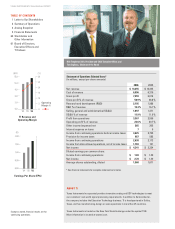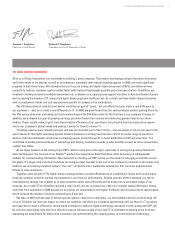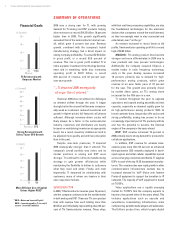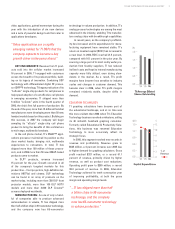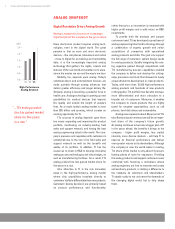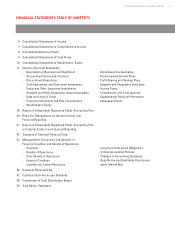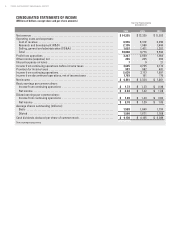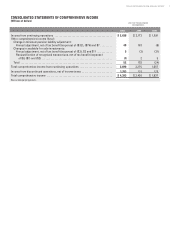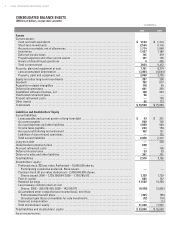Texas Instruments 2006 Annual Report Download - page 6
Download and view the complete annual report
Please find page 6 of the 2006 Texas Instruments annual report below. You can navigate through the pages in the report by either clicking on the pages listed below, or by using the keyword search tool below to find specific information within the annual report.
TEXAS INSTRUMENTS 2006 ANNUAL REPORT
4
ANALOG SNAPSHOT
Digital Revolution Drives Analog Growth
Analog is expected to become an increasingly
important part of the company in the years ahead.
Every electronics product requires analog tech-
nologies, even in the digital world. The great
paradox is that as more and more electronic
devices – like cell phones, televisions and radios
– move to digital for processing and transmitting
data, it is the increasingly important analog
technology that gathers the sights, sounds and
textures of the real world and enables us to expe-
rience the movies we see and the music we hear.
Mobility, too, depends upon analog. Today’s
communications and entertainment devices are
made portable through analog advances that
deliver greater efficiency and longer battery life.
Similarly, analog is becoming a powerful force in
health care. Analog technology is opening up new
possibilities for medical devices that improve
the quality and extend the length of people’s
lives. As a result, today’s analog market is more
than $35 billion and growing, which creates an
exciting opportunity for TI.
TI’s success in analog depends upon three
key areas: expanding and improving the product
portfolio, maintaining an industry-leading field
sales and support network, and having the best
analog engineering talent in the world. The com-
pany’s presence and reputation with customers is
unmatched due to the size of its field sales and
support network as well as the breadth and
quality of its portfolio. In addition, TI has the
resources to invest in R&D to develop innovative
analog process technologies and chip designs, as
well as manufacturing facilities. As a result, TI’s
analog product line has gained market share for
five years in a row.
Also attractive to TI is the role innovation
plays in the high-performance analog market
where chip capabilities translate directly to
customers’ ability to differentiate their own products.
Customers’ buying decisions are primarily based
on product performance and functionality,
rather than price, so innovation is rewarded with
higher profit margins and a solid return on R&D
investments.
To provide both the products and support
customers need, TI has developed a great base of
analog engineering talent and technology through
a combination of organic growth and select
acquisitions of companies with specialized
analog products and skills. The goal is to support
the full range of customers’ system design needs
for analog products. Quickly integrating the ana-
log expertise gained through acquisitions with
TI’s manufacturing process capabilities enabled
the company to define and develop the cutting-
edge processes and tools that allowed its newly
acquired talent to develop best-in-class products.
Today, with more than 15,000 high-performance
analog products and hundreds of new products
in the pipeline, TI’s portfolio has become stronger,
more differentiated and more attractive to a
broader set of customers. Moreover, it enables
the company to create products that are highly
tuned for targeted opportunities, such as cell
phones, hard-disk drives and automobiles.
Analog now represents about 40 percent of TI’s
total Semiconductor revenue and will be an impor-
tant driver of the company’s future growth.
As analog continues to become a bigger part of TI
in the years ahead, the benefits it brings to the
company – higher profit margins, less capital
intensity, more diverse markets – will help TI to
improve its financial performance and deliver
even greater returns to its shareholders. Although
the company is now the world leader in analog,
TI’s share of this market is only about 13 percent,
leaving plenty of room for expansion. Providing
the analog products and support customers need,
combined with fostering a workplace where
analog engineers are free to innovate and create
extraordinary products, is making a difference to
the company, its customers and shareholders.
TI stands ready to not only meet the demands of
the changing digital world, but to help shape
them.
“ ...TI’s analog product
line has gained market
share for five years
in a row.”


